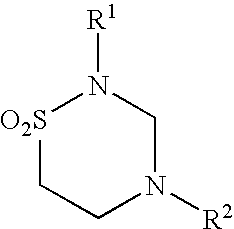Resorbable extracellular matrix for reconstruction of bone
a bone and extracellular matrix technology, applied in the field of bone reconstruction, can solve the problems of loss of strength and shape, inability to duplicate the composition and structure of natural bone mineral composition and structure, and undesirable use of pgs in the form of pgs
- Summary
- Abstract
- Description
- Claims
- Application Information
AI Technical Summary
Problems solved by technology
Method used
Image
Examples
example 2
[0126] The extract resulting from alkaline treatment in Example 1 contained glycosaminoglycan, alkali, denatured proteins and salts. The extract was firstly neutralized with HCl, the pH value after neutralization being 6. The extract was then treated with a filter aid, namely kieselguhr, which had the effect of removing the denatured proteins. 0.5 weight percent of kieselguhr was introduced into the extract and removed by filtration together with the denatured protein.
[0127] The supernatant was then submitted to ultrafiltration using a membrane having a molecular weight cut off at about 10000 daltons. In this way, salts were removed to leave purified glycosaminoglycan.
[0128] The glycosaminoglycan solution so obtained was admixed with collagen material from above to provide a collagen II matrix containing glycosaminoglycan.
example 3
[0129] (1) Determination of Hexosamine and Amino Acid Residues in Collagen Sponges and Fleeces
[0130] Each sample, exactly weighed (about 10 mg) was hydrolyzed in 10 ml of 3M or 6M HCl at 1.05.degree. C. for 15 or 20 hours under purified nitrogen in a sealed tube. After cooling the tube in a refrigerator and opening the tube, the contents were transferred to a 25 ml long neck flask and dried at 40.degree. C. in a vacuum-rotation dryer (Rotavapor RE120, Buchi, Switzerland) under water jet vacuum. After dissolving the residue in 5 ml water, the residue was again dried under water jet vacuum. Subsequently, the residue was taken up in 5 ml loading buffer (0.2M relative to Na+) at pH 2.2. For determination of the glucosamine and galactosamine values, after previous dilution of an aliquot with loading buffer (1+10) 150 .mu.l of the sample hydrolyzed in 3M HCl was injected into the cartouche of an amino acid analyzer (AlphaPlus, type 4151, Pharmacia-LKB, Freiburg) and evaluated by compariso...
example 4
[0134] Bovine femur bones were boiled in hot water until clean, comminuted to a particle size of 5 to 10 mm. and extracted under reflux with toluene for 24 hours in a Sohxlet apparatus. The material was further extracted with ethanol to remove toluene and then extracted at elevated temperature with an azeotropic mixture of ethylene diamine and water (85:15) for 8 days, with several changes of solvent until substantially no further organic material was extracted. The product was then air dried at 100.degree. C.
[0135] The dried product was further comminuted to an average particle size of 0.2 to 2 mm and sterilized in the autoclave. Pieces of bovine femur spongifosa bone, typical diameter 10 mm, were purified by the same technique, omitting the final granulation.
PUM
| Property | Measurement | Unit |
|---|---|---|
| pore size | aaaaa | aaaaa |
| pore size | aaaaa | aaaaa |
| pore size | aaaaa | aaaaa |
Abstract
Description
Claims
Application Information
 Login to View More
Login to View More - R&D
- Intellectual Property
- Life Sciences
- Materials
- Tech Scout
- Unparalleled Data Quality
- Higher Quality Content
- 60% Fewer Hallucinations
Browse by: Latest US Patents, China's latest patents, Technical Efficacy Thesaurus, Application Domain, Technology Topic, Popular Technical Reports.
© 2025 PatSnap. All rights reserved.Legal|Privacy policy|Modern Slavery Act Transparency Statement|Sitemap|About US| Contact US: help@patsnap.com



